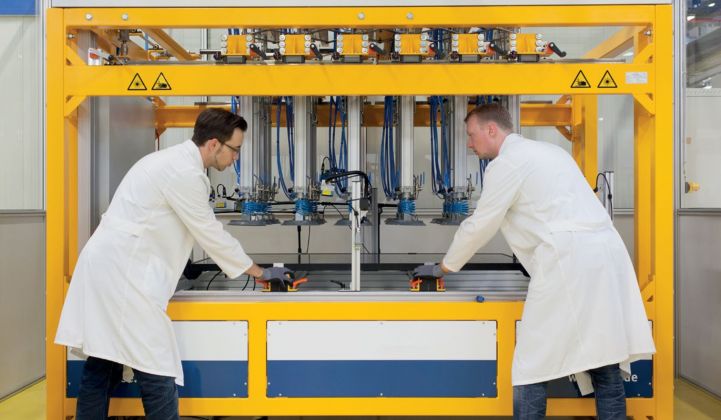President Trump's recently imposed solar tariffs appear to be working. Or, at least, solar companies are finding ways to work with them.
Hanwha Q Cells Korea Corporation announced today that it will build a solar PV module manufacturing facility in Whitfield County, Georgia. Construction will commence in 2018, and the facility is scheduled to be completed in 2019.
The company did not disclose the exact nameplate capacity of the new facility, but confirmed that it will exceed 1.6 gigawatts per year. Hanwha Q Cells Korea will manufacture PERC solar modules in the U.S., with 100 percent of production made available to Hanwha Q Cells Co. Ltd. to serve the rooftop and ground-mount market segments.
Today's announcement comes roughly four months after the Trump administration imposed tariffs on imported solar cells and modules. The Section 201 trade case and resulting tariffs very likely played a role in the Hanwha's decision, as U.S.-made products are not subject to trade remedies. The firm, however, framed its investment in broader strategic terms.
"The new manufacturing fab is testament to Hanwha Q Cells Korea's commitment to the U.S. market, in spite of the recently imposed trade barriers," the company stated in a press release.
Hanwha Q Cells said that its new U.S. manufacturing plant will enable the company to maintain a leading market position in America and even widen its U.S. customer base. The U.S. was the second-largest solar market in 2017, and "one of the most important markets for Hanwha Q Cells Korea," the company said.
With the completion of the Georgia facility, Hanwha Q Cells Korea, together with affiliate Hanwha Q Cells, will have manufacturing facilities operational in South Korea, Malaysia, China and the U.S.
MJ Shiao, global lead for renewables and emerging technologies at Wood Mackenzie, wrote earlier this year that the Section 201 trade case was unlikely to trigger a U.S. solar manufacturing renaissance. In response to recent announcements, he acknowledged that President Trump's tariffs do seem to playing a role in encouraging more U.S.-based solar production — but remained skeptical of how effective they'll be in fostering a healthy American solar manufacturing market.
The Hanwha Q Cells decision "is certainly a result of tariffs — and Section 201 seems to be the catalyst," said Shiao. "But remember that Chinese manufacturers have now had to deal with three sets of tariffs targeting solar imports to the U.S., as well as in Europe and now in India. I think there's also a point where module manufacturers are tired of fighting tariffs in major markets and see domestic manufacturing as a hedge against future trade action."
There are also negative cost impacts even with tariff-free domestic solar manufacturing. U.S. manufacturing doesn't necessarily drive down the cost of solar modules. As a result, tariffs could still have a downward effect on solar project deployments, dampening overall growth in the U.S. solar market.
Furthermore, unless companies choosing to open new U.S. solar facilities find ways to dramatically cut costs, particularly as tariff levels decline and the federal Investment Tax Credit (ITC) sunsets, these manufacturing plants may quickly become economically unviable.
Any new solar module build-out will also have to compete for the 2.5 gigawatts per year of solar cell imports that are exempted under the Section 201 tariffs. According to Wood Mackenzie/GTM Research, crystalline silicon cell imports have been low in recent months, with less than 5 percent of the quota used up since the tariffs took effect in February. This dynamic could soon change as new facilities begin to ramp up.
"I still have concerns about the long-term competitiveness of these module assembly facilities versus imports once the tariffs expire," said Shiao. "These manufacturers will need an aggressive cost-reduction road map once both the tariffs sunset and the ITC phases out if they look to remain in operation."
More than 3 gigawatts' worth of new domestic module assembly capacity (and 1.2 gigawatts of cell production in the case of First Solar) has been announced over the past few months. In addition to Hanwha, there have been major manufacturing announcements from China's Jinko Solar and U.S.-based SunPower.
If all new facilities and expansions (beyond the major ones referenced above) come to fruitition, Wood Mackenzie/GTM Research expects the U.S. could see well over 6 gigawatts of module production capacity by the end of 2019.




